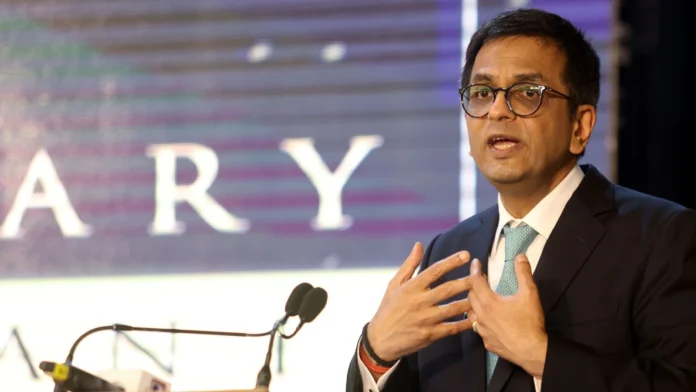The highest chair in the Indian judiciary was never meant to compete with the privileges of political office. It was meant to rise above them. Yet, the decision of former Chief Justice of India D.Y. Chandrachud to overstay in the official CJI residence — Bungalow No. 5, Krishna Menon Marg — more than eight months after retirement, even after the expiry of the permissible period and its extension, has caused visible damage to the image of an institution that has long projected itself as the guardian of constitutional values.
This isn’t a routine breach of housing protocol. It’s a symptom. A symptom of how the institutional culture of entitlement has now permeated even the judiciary — a domain that has historically demanded restraint, dignity, and a clear separation from executive indulgence. When the Supreme Court’s own registry is compelled to write to the Union government, seeking the urgent vacation of the CJI’s official residence from its former occupant, it indicates not just discomfort but a systemic breakdown in internal discipline.
The letter dated 1 July 2025, from a Supreme Court official to the Ministry of Housing and Urban Affairs (MoHUA), is blunt. It states that not only has the six-month retention period under Rule 3B of the 2022 Rules expired on 10 May 2025, but even the special extension granted until 31 May 2025 has lapsed. Despite this, the former CJI — someone hailed during his tenure as a symbol of constitutional progressivism — has continued to occupy the bungalow, prompting the court itself to seek administrative enforcement.
The former CJI, in his defence, has stated that his bags were always packed — and still are — and that he never intended to overstay. He attributes the continued occupation of the official residence to the medical needs of his two adopted daughters. Yet, going by statements in the press outlining these reasons, the optics are far from reassuring. The medical conditions of his daughters were neither sudden nor unforeseeable. With over two years at the helm of the judiciary, was there truly no opportunity to make timely arrangements — such as installing accessibility ramps — in the residence he was meant to occupy post-retirement? That such preparations were not made well in advance does not reflect well on the office he once held. It signals poor planning at best, and a sense of privilege at worst.
Many are not seeing this entire episode as an administrative oversight. This is being seen as a conscious act of privilege, one that goes against the very ethos of the chair Chandrachud once held. And it matters precisely because it is Chandrachud.
He was not an invisible judge. He was not a bureaucrat-turned-judge looking for post-retirement sinecures. He was, in the eyes of many, the most articulate, liberal, and publicly admired Chief Justice India has had in decades — someone who delivered landmark judgments and gave speeches that spoke of empathy, dignity, and discipline. That the same man today finds himself clinging to a Lutyens bungalow — long after his term and long after the rules allowed — shatters that near perfect image.
At any other time, this episode may have been brushed aside as a personal misstep. But it comes at a moment when the judiciary is already under serious public scrutiny, especially with regards to judges positioned in the Delhi High court.
So, when the former CJI refuses to vacate the very bungalow designated for the sitting Chief Justice, it’s no longer a standalone incident. It is seen as a part of a pattern. A pattern that tells the public that judges are beginning to behave like ministers, and that the judiciary, like the executive, is growing too comfortable with impunity.
This matters because the judiciary, unlike the political class, operates without the checks of re-election or public trial. It is shielded through carefully crafted Constitutional wordings from immediate consequences. It is also the only institution that polices the conduct of the other two branches. If that institution’s leaders begin to live by selective adherence to law, what credibility remains when they ask others to follow it?
Those defending the former CJI will argue — as they already are in whispers — that the overstay was harmless, that no great injustice has occurred. But that argument holds no water. Because symbolism matters. And so does precedent.
If a former Chief Justice can overstay despite the rules, what prevents other judges — high court or subordinate — from pushing similar boundaries? And how will the Supreme court, in the future, admonish the ministers, the politicians who see overstaying as a responsibility and duty?
If the Supreme court registry had not stepped in, would this have continued indefinitely? Would it have been regularized silently?
There is also the question of internal accountability. Why did the Registry take so long to write this letter? Why was it not raised earlier? The silence from within is as disturbing as the act itself.
It tells us that institutional hesitation is now the norm — that even in the face of clear violations, the system prefers internal courtesy over public responsibility.
Justice Chandrachud’s judgments will continue to be cited. His legacy on issues like privacy, gender equality, and constitutional morality is significant. But it will now carry an asterisk. The man who spoke of transparency and integrity in public office — who once warned that “public power must be exercised with humility” — has himself left behind a trail of contradiction.
In India, we are used to retired politicians clinging to power, refusing to vacate bungalows, lobbying for Z-category security, and demanding post-retirement relevance. But the judiciary was meant to be the counterweight — an institution above the everyday pettiness of state-sponsored comfort. When that institution falters, the damage is not just reputational. It is constitutional.
If this incident doesn’t trigger a wider conversation about judicial accountability and internal audits, then the system is learning nothing. If we allow this to pass as a footnote, then the footnote will become precedent.
For decades, the Indian judiciary asked others to follow rules. This time, it must show that it can follow its own rules.








